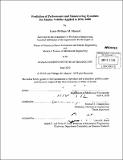Prediction of performance and maneuvering dynamics for marine vehicles applied to DDG-1000
Author(s)
Menard, Louis-Philippe M
DownloadFull printable version (6.557Mb)
Other Contributors
Massachusetts Institute of Technology. Dept. of Mechanical Engineering.
Advisor
Michael S. Triantafyllou.
Terms of use
Metadata
Show full item recordAbstract
Being able to accurately model the performance of ships is an integral part of the ship design process. A considerable amount of money is invested into predicting how a ship will maneuver in a given sea state. Furthermore, it is vital to understand the powering requirements and potential limitations of the ship design. Typically, a physical scale model of the ship is constructed and experimented on in a tow tank to determine the hydrodynamic characteristics of the ship to be built. This can also be expensive. Therefore, there is considerable interest in developing a means to predict the hydrodynamic performance of a ship using alternative means. This thesis presents an analytical determination of the hydrodynamic coefficients for the DDG-1000 and compares them to an existing physical model with the intent to use the physical model as a substitute. Using analytical methods from several established sources, this thesis develops a simulated model for the DDG-1000 that is consistent with expected performance of a ship of this size and class. In addition, this thesis presents a model for the all-electric ship using azimuthing propellers. The analytically determined maneuvering dynamics are applied to the full all-electric ship system model, which incorporates the main generating engines through the power electronics to the motor and propulsion shafts. The results of the simulation form a baseline, from which future optimization of the model can occur.
Description
Thesis (S.M. in Naval Architecture and Marine Engineering)--Massachusetts Institute of Technology, Dept. of Mechanical Engineering; and, (S.M.)--Massachusetts Institute of Technology, Dept. of Mechanical Engineering, 2010. Cataloged from PDF version of thesis. Includes bibliographical references (p. 71-73).
Date issued
2010Department
Massachusetts Institute of Technology. Department of Mechanical EngineeringPublisher
Massachusetts Institute of Technology
Keywords
Mechanical Engineering.